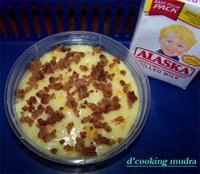 Ingredients:
Ingredients:- 2-1/4 cups coconut thin milk
- 2/3 cup cornstarch
- 3/4 cup white sugar
- 1 can cream style corn
- 2 tbsps butter, room temperature
- 1/4 tsp vanilla
Procedure:
In a thick bottom casserole, combine the first-two ingredients. Mix until sugar dissolves. Place over medium-low fire. Stir continuously until it thickens. Remove from fire.
Add in the cream-style corn and butter. Bring back to the stove. Cook for another 2-3 minutes or until very thick, should continue stirring to avoid sticking at the bottom of the pan.
Remove from heat. Drizzle with vanilla flavoring. Mix well. Pour in a molding container or several small containers. Sit at room temperature until it cools. Cover, then, put inside the refrigerator.
Serve cold.







